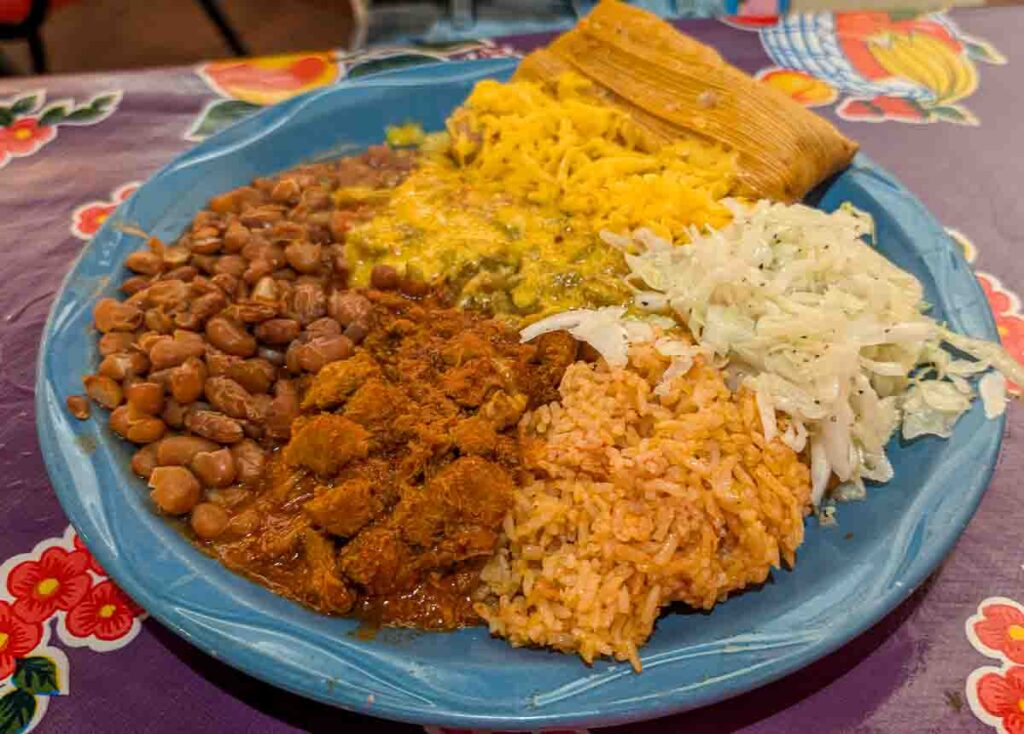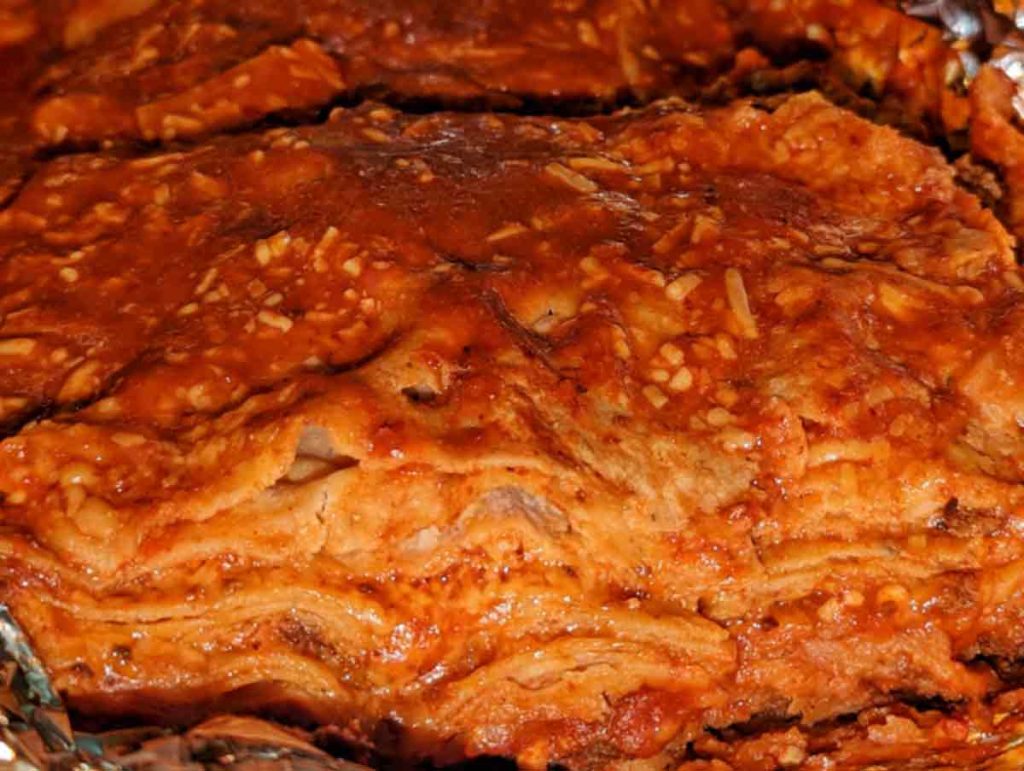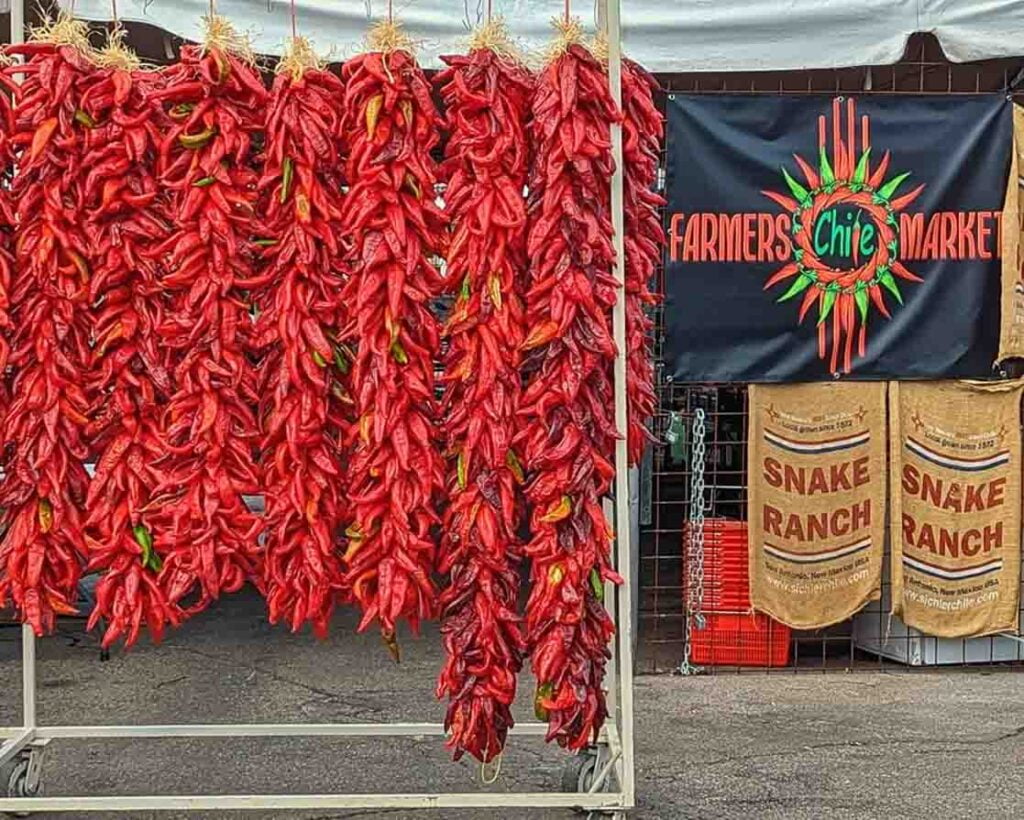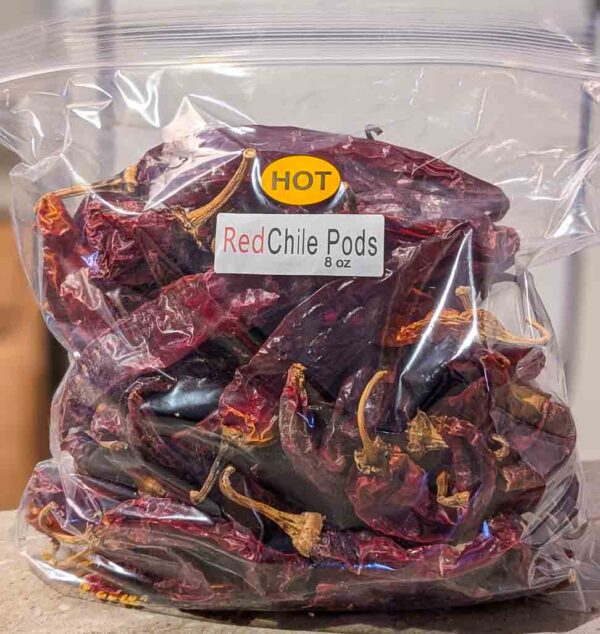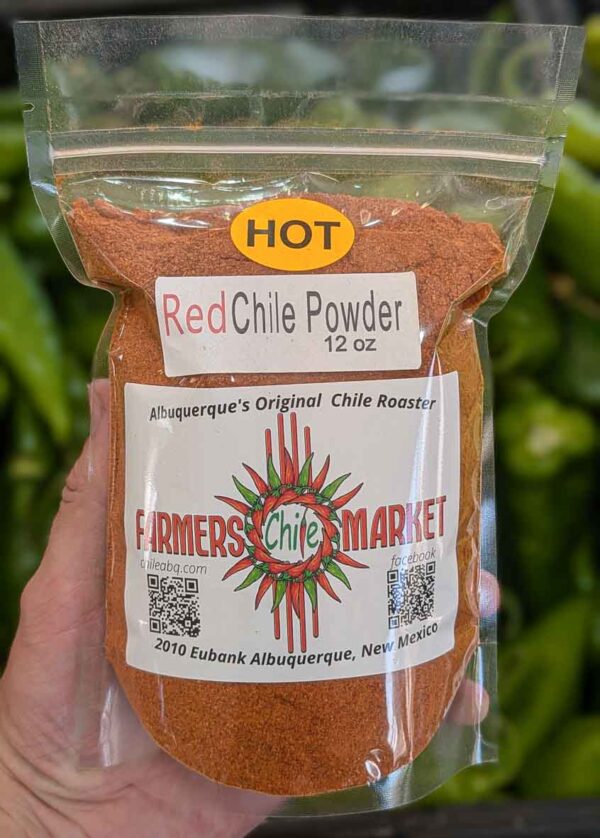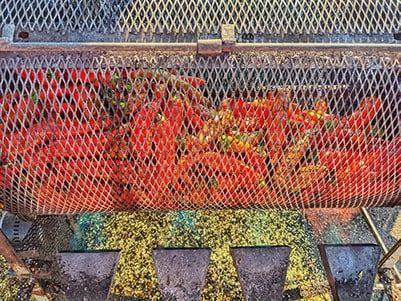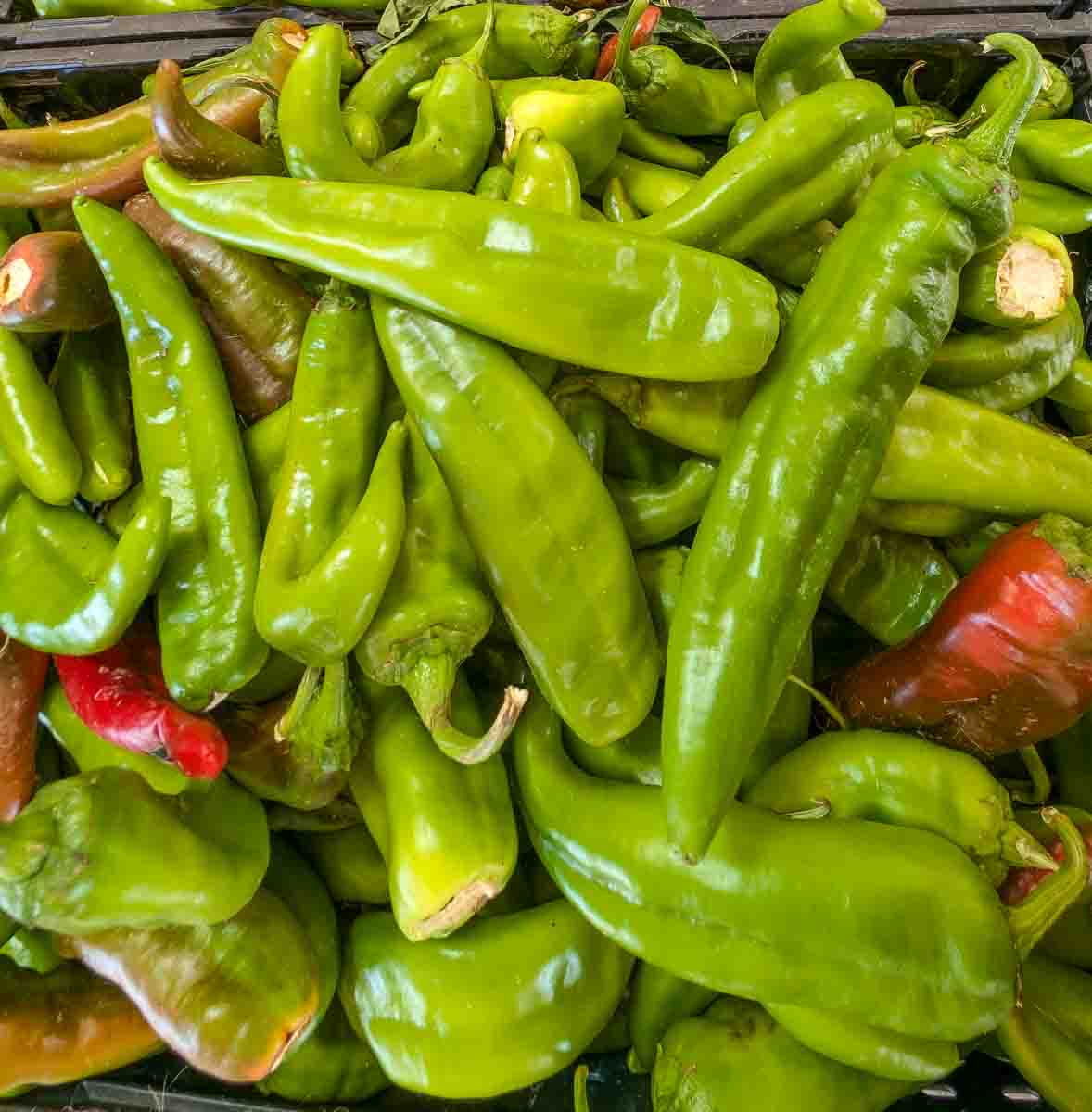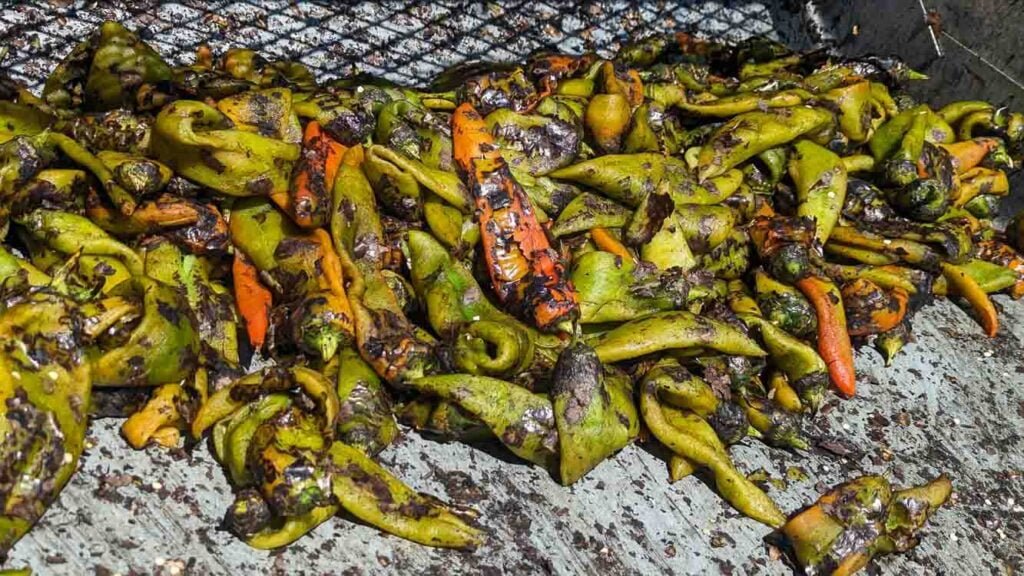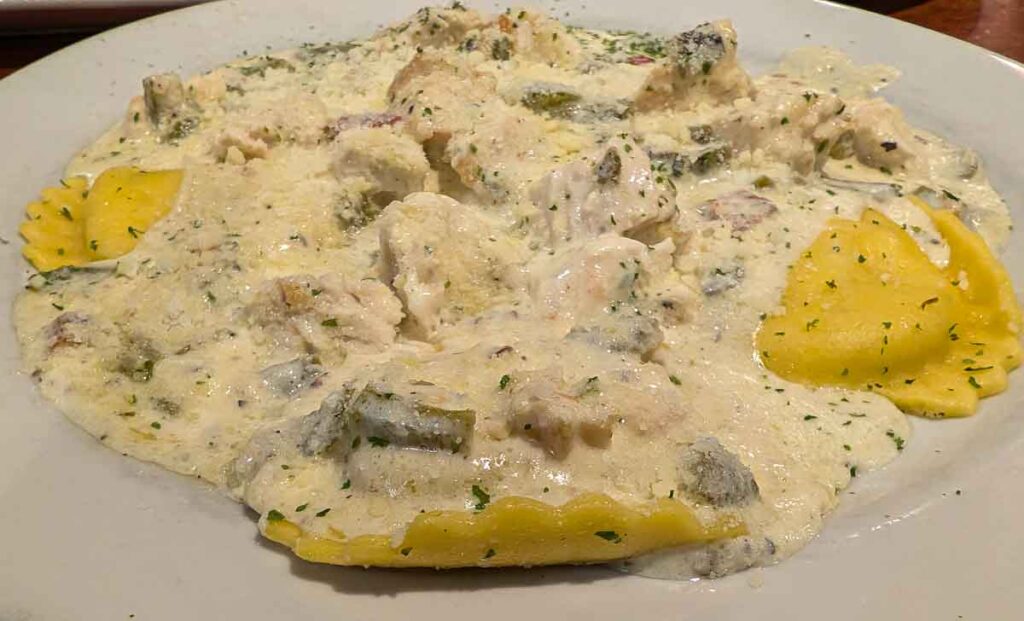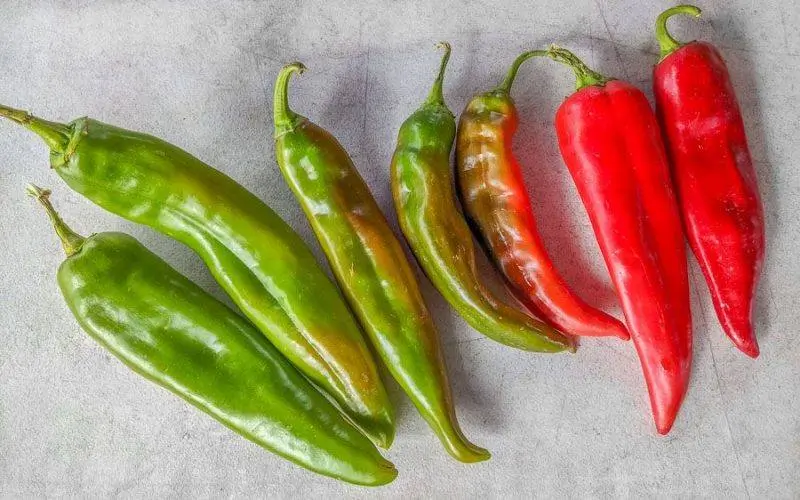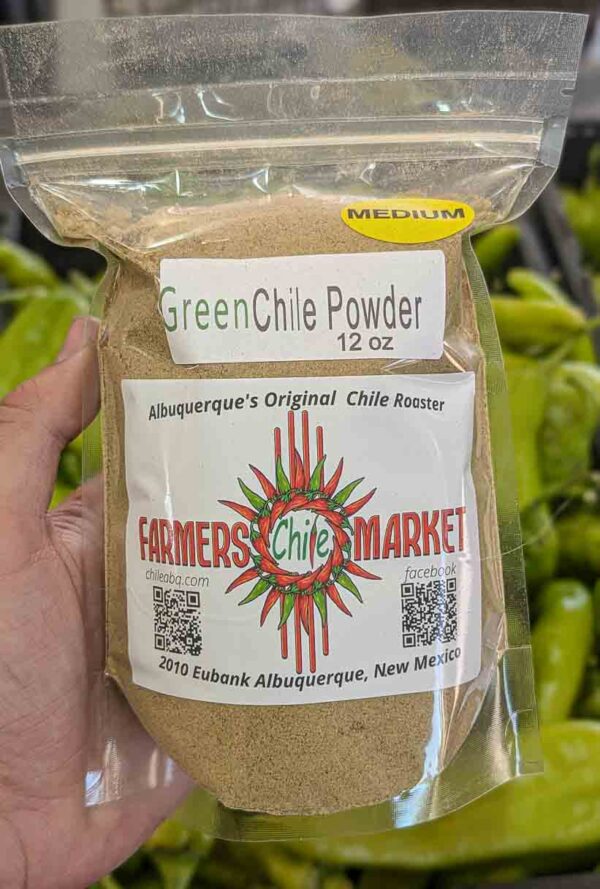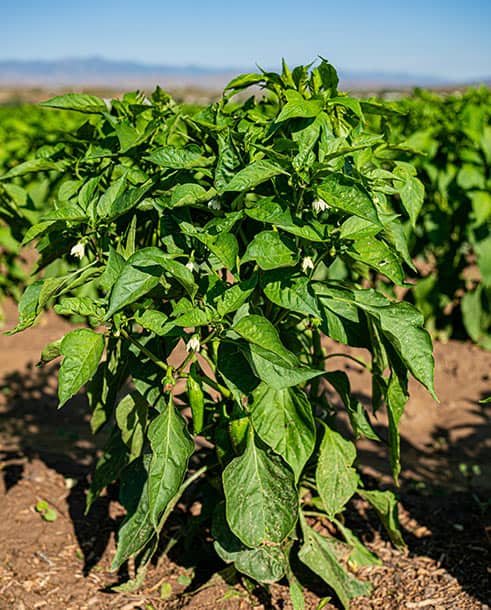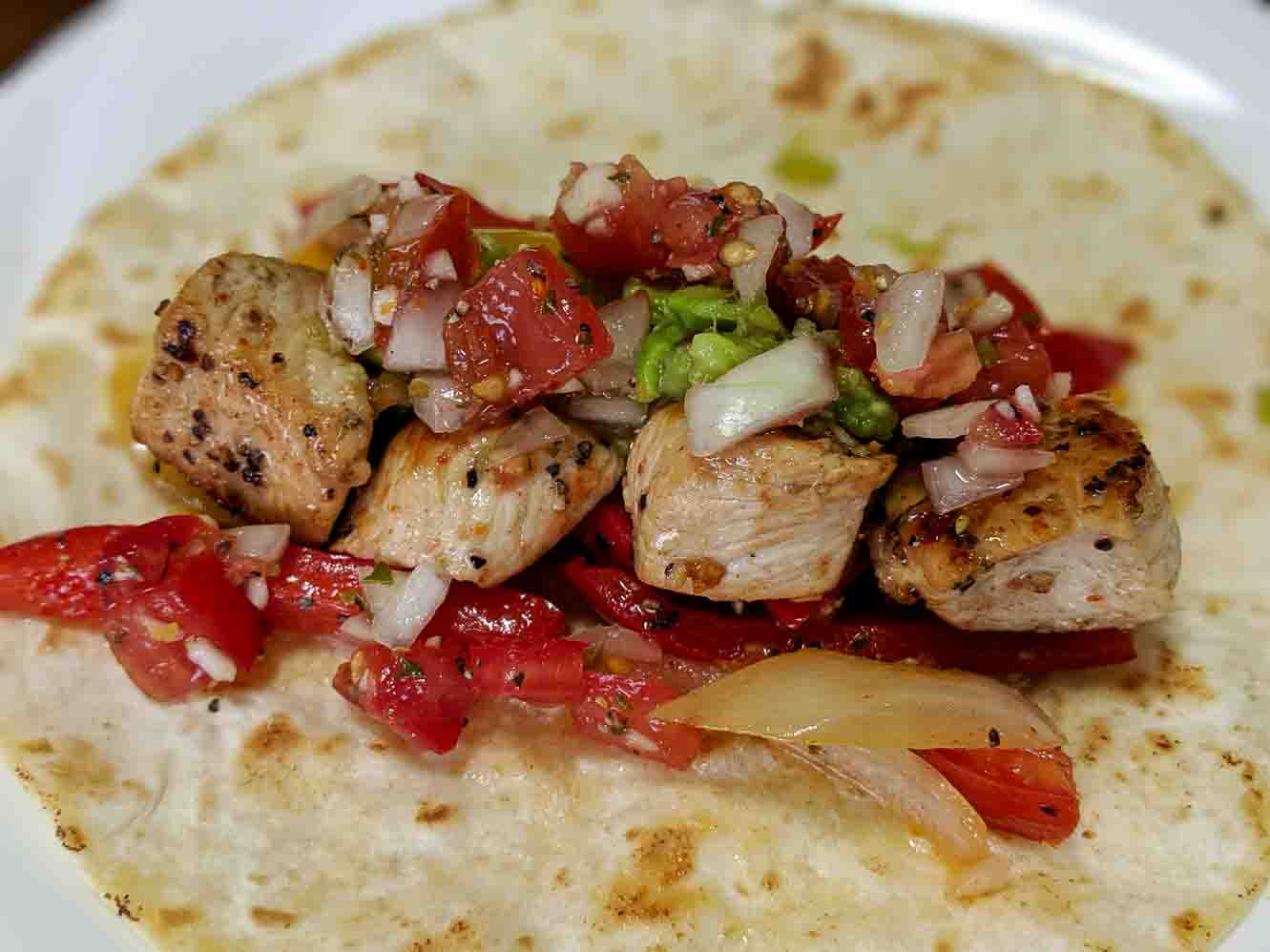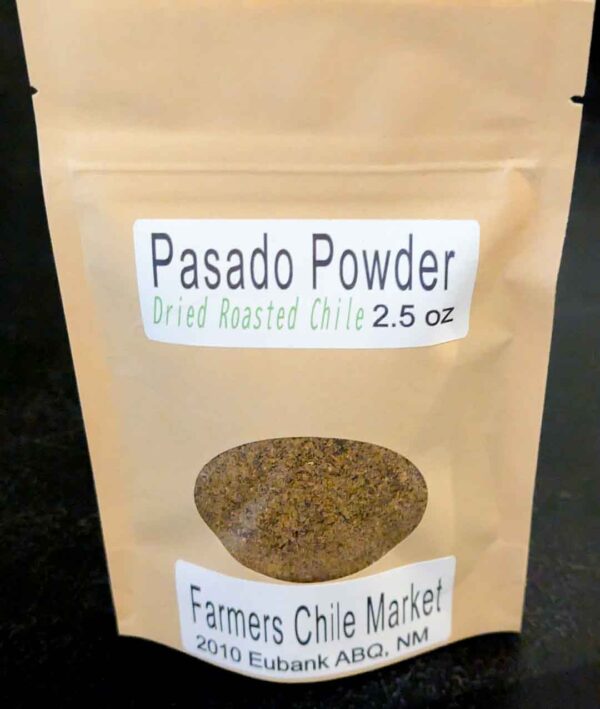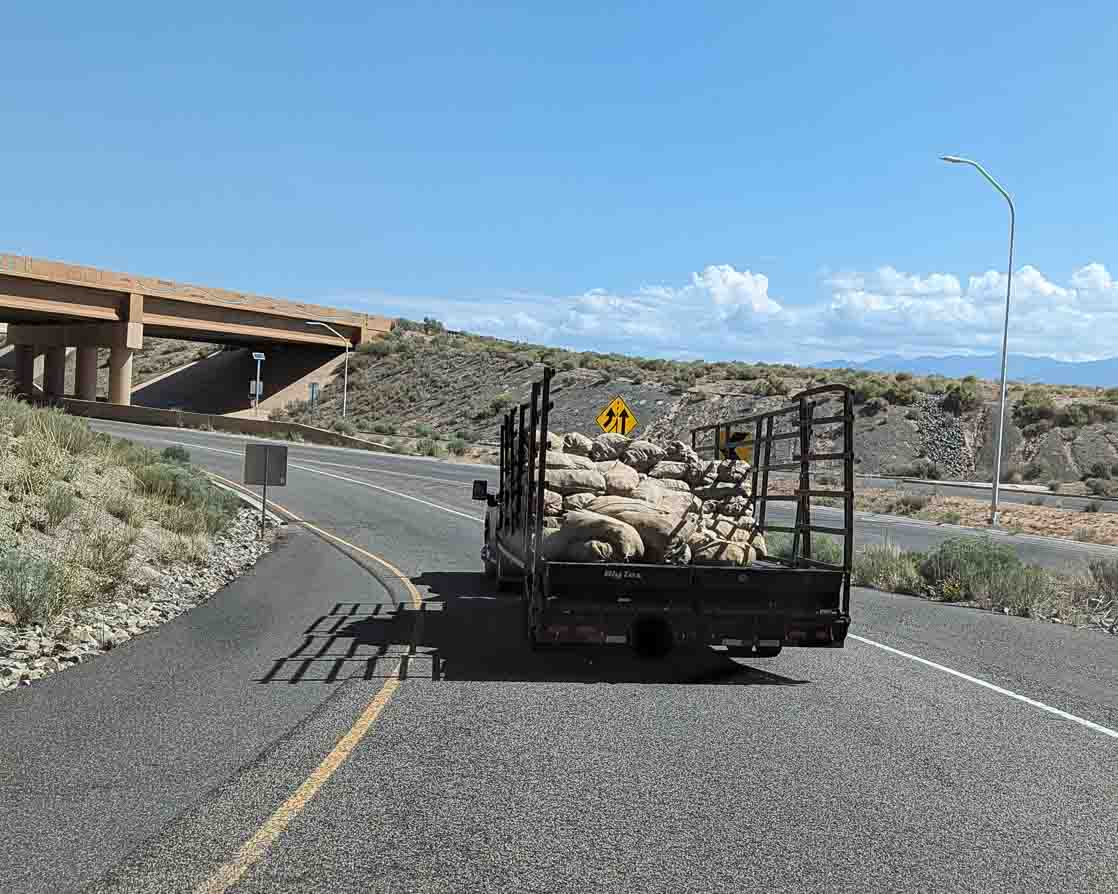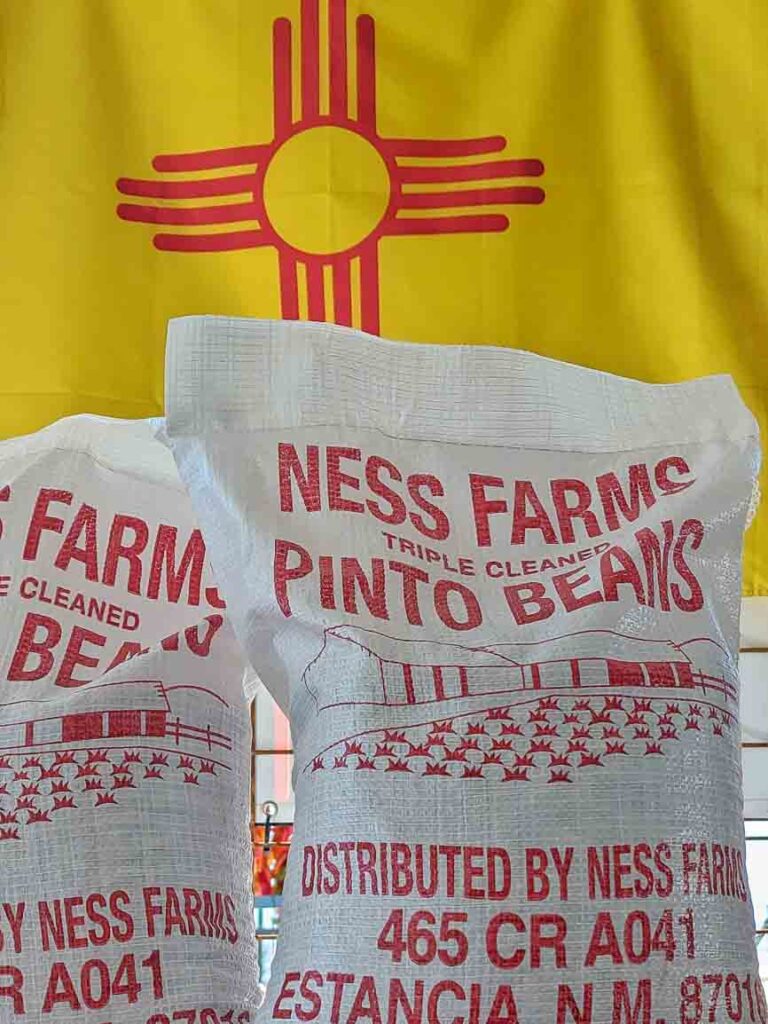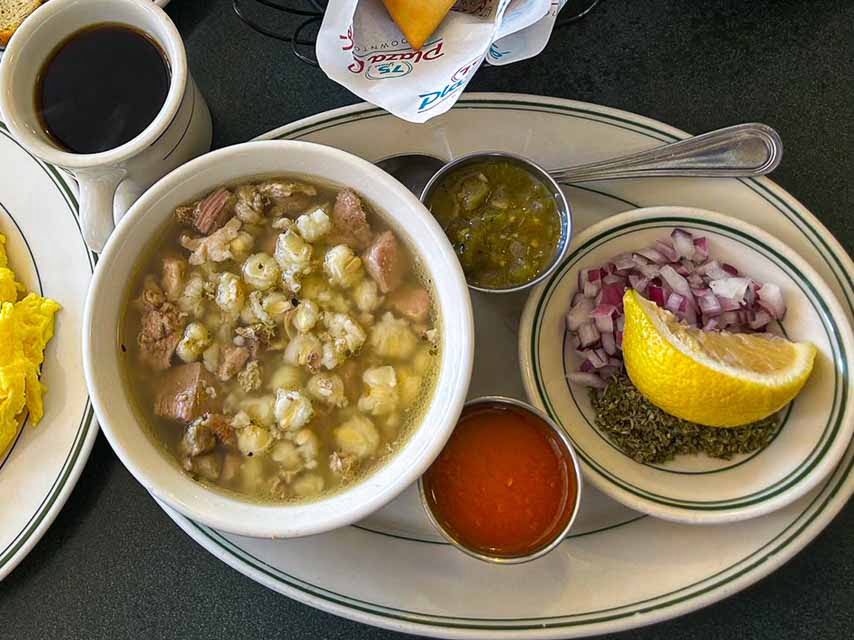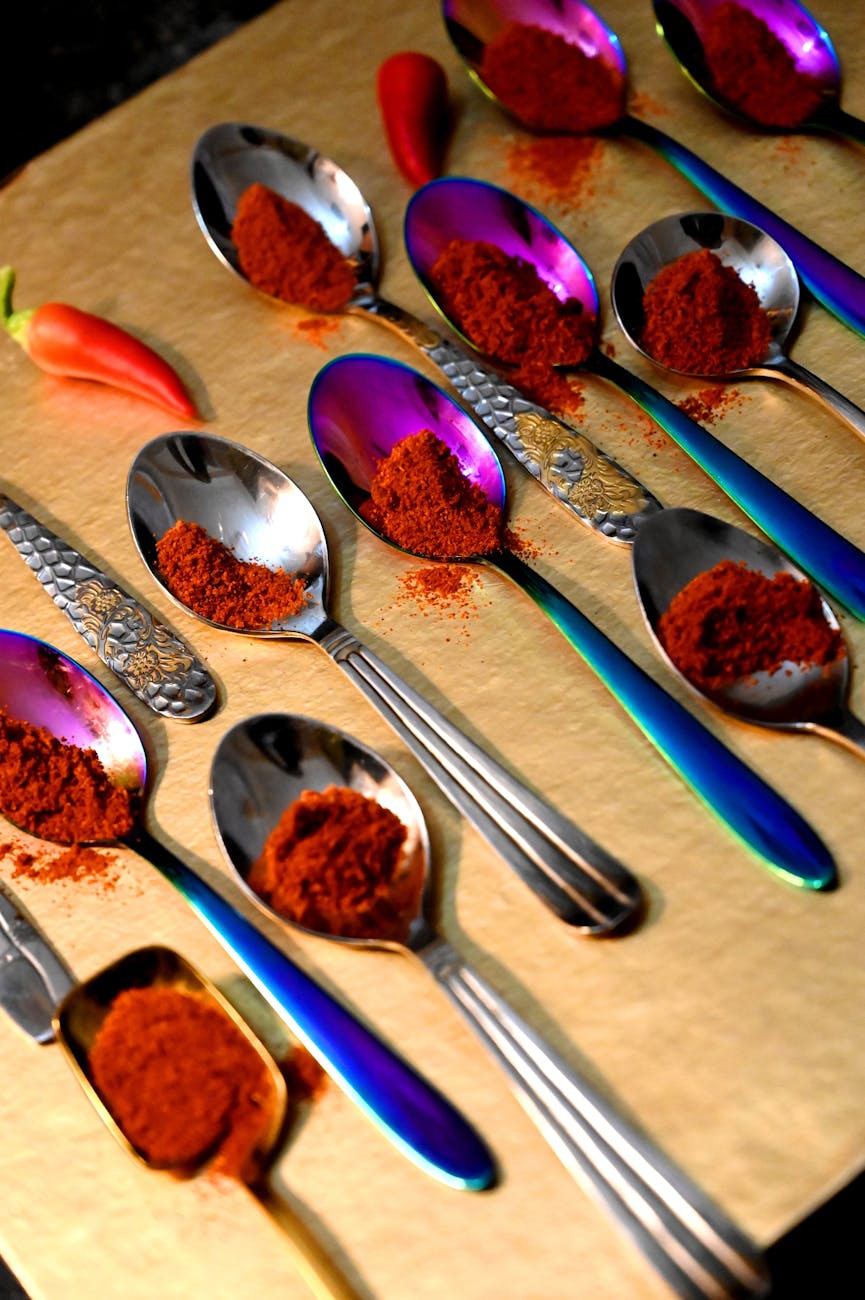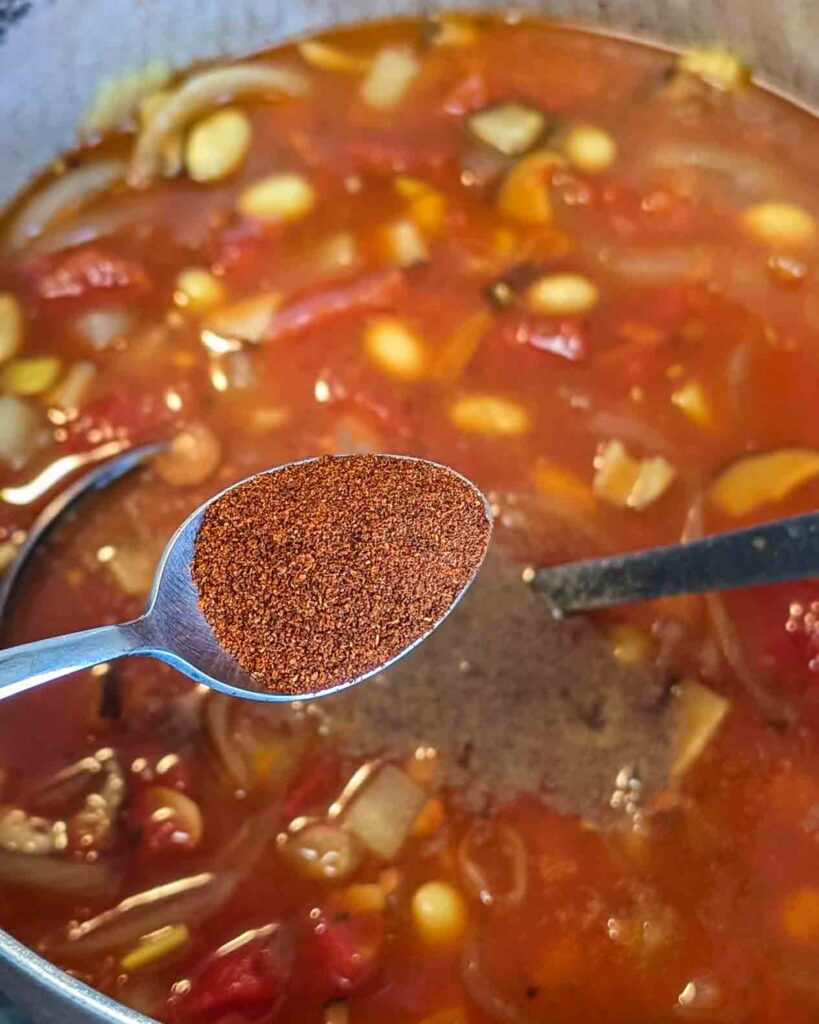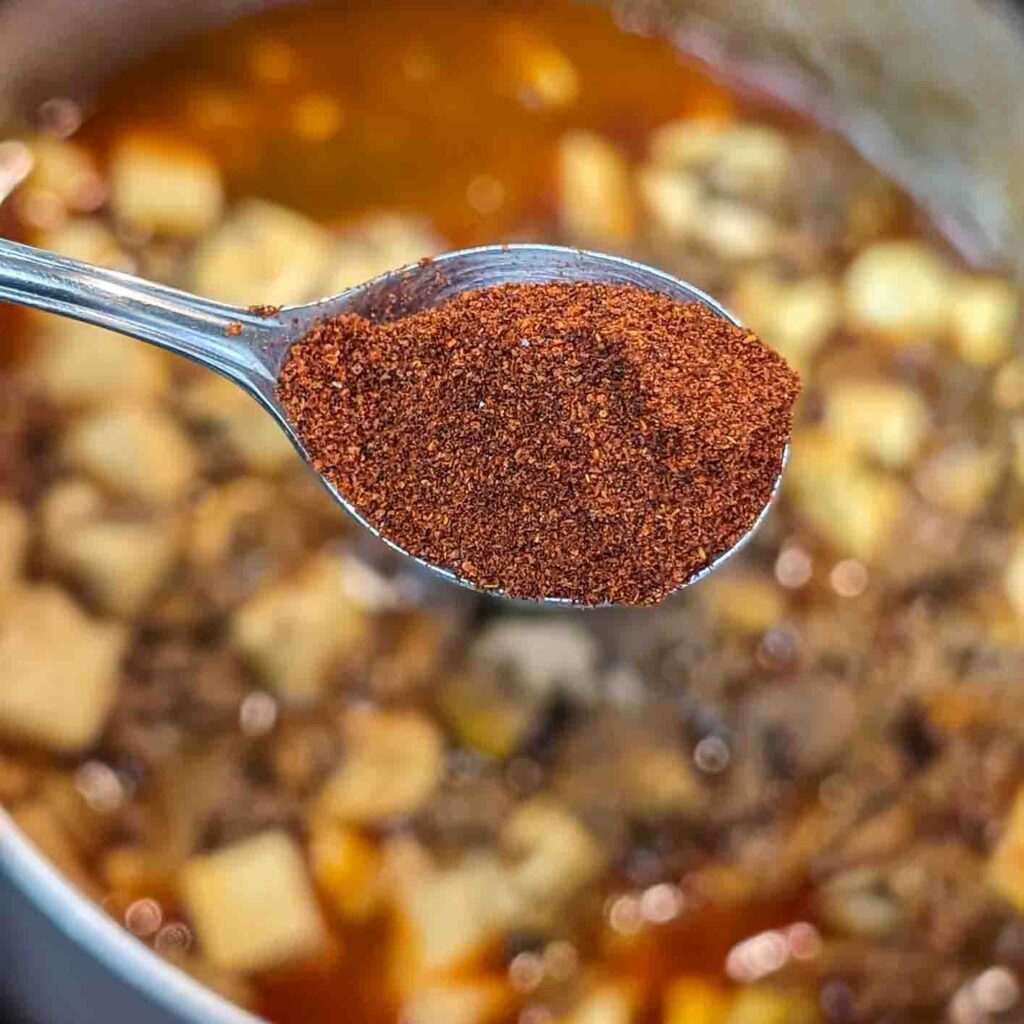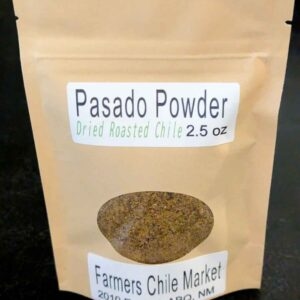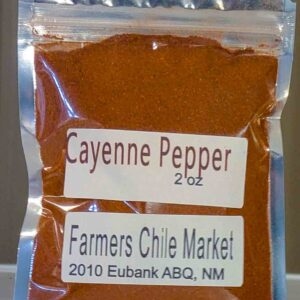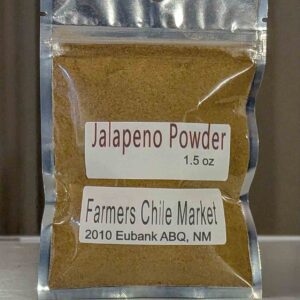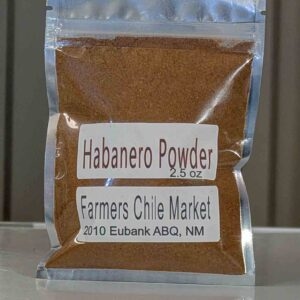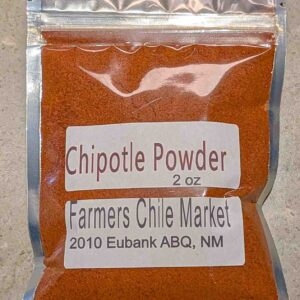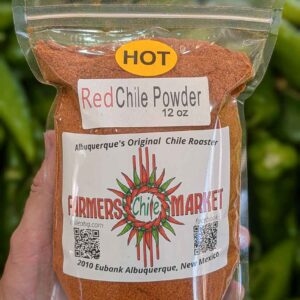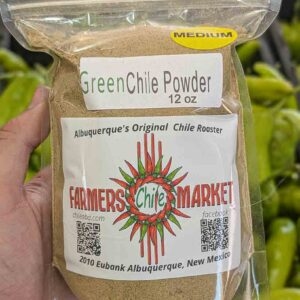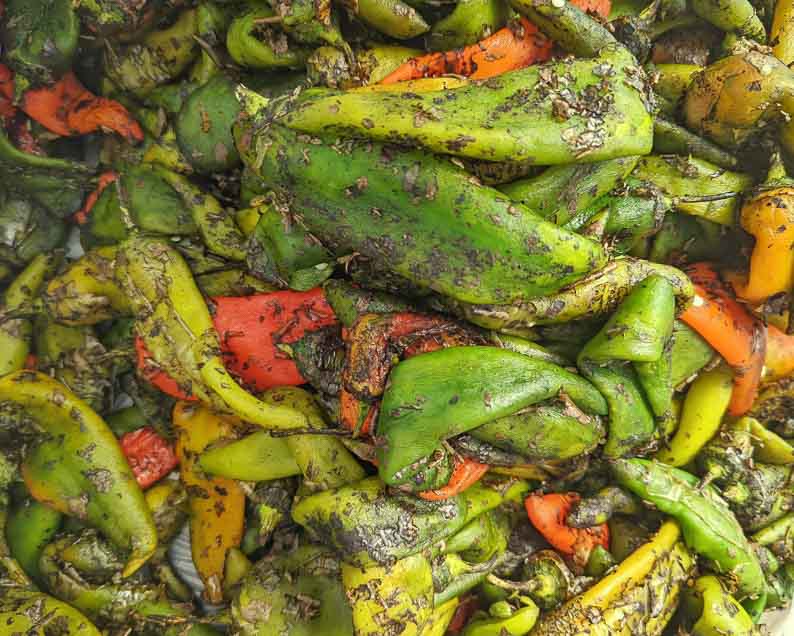Your cart is currently empty!
Category: Cooking
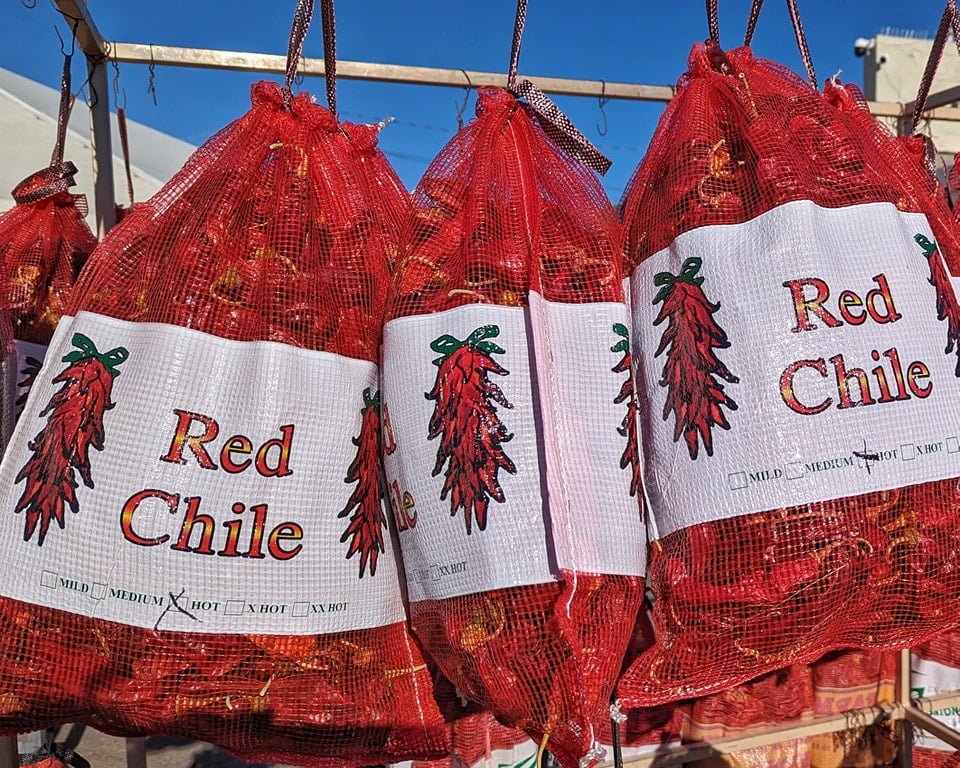
Hatch Red Chile
The other side of the Red or Green question, Hatch red chile is a huge part of New Mexican cuisine! Although most people think of Hatch red chile as only dried red chile pods, it also encompasses fresh red chile too. Without red chile, New Mexican cuisine, particularly in the colder months would be incomplete.
Red Chile Sauce
Unlike Hatch green chile, red chile is typically not used as a topping. Instead it’s almost always made into a sauce by boiling and blending. It’s quite simple to make, as it just takes a short boil time, then a long blend time. Many people often like to incorporate cloves of garlic along with other spices. For a very detailed breakdown on how to make a red chile sauce, including using red chile powder, be sure to read our recipe for red chile sauce.
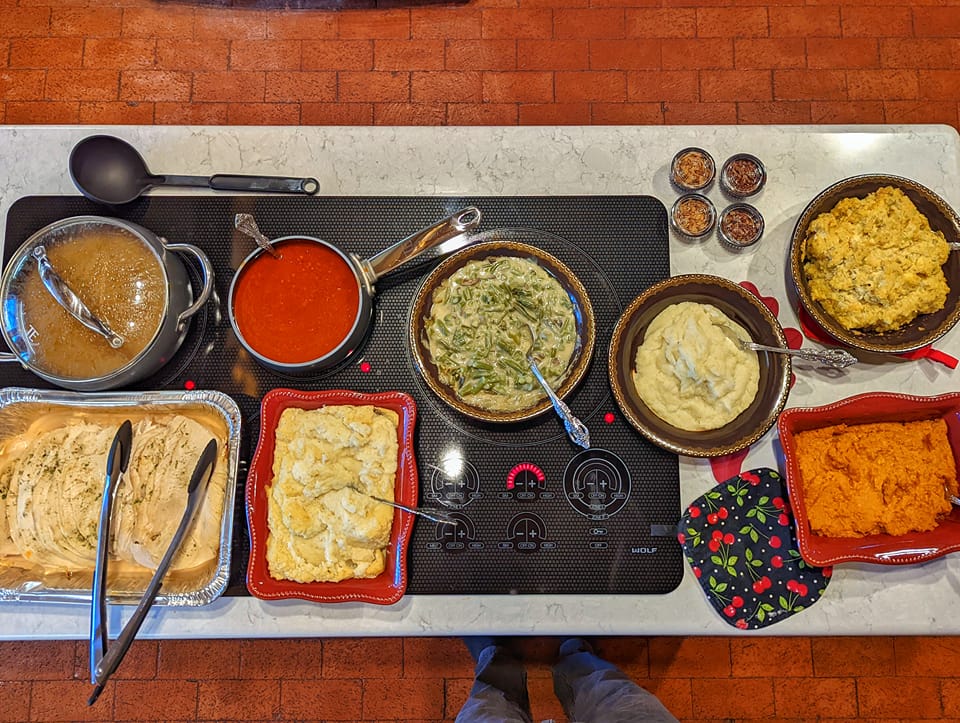
The red chile sauce is right in the middle Common Red Chile Dishes
Carne Adovada
Carne Adovada is a dish made with pork, most often pork shoulder and red chile sauce. Personally I like to make it in a slow cooker with chile pods that fall off of chile ristras. It’s a very simple recipe that just requires red chile sauce, pork, and time. I like to sear the pork with a cast iron pan before throwing it into the slow cooker, but fundamentally it just needs a slow cooker or Dutch oven, pork, and red chile sauce. Leave it on all day, and come back for a great red chile pork dinner.

The carne adovada was the centerpiece of this dish Vegetarian Option
In my experience, you can also simmer jackfruit or firm tofu in a red chile sauce and have a similar option to carne adovada. It goes quite well in a burrito with some cheese and scrambled eggs!
Tamales
Another dish which most often involves pork and red chile, tamales are a great red chile based dish in New Mexico! Tamales are a dish most commonly eaten in colder months, and most households in New Mexico have a potful of them at Christmas for anyone to come and eat when they are feeling peckish. The recipe is not too different from carne adovada, except that you need to prepare masa first, then stuff your red chile and pork mixture into masa and wrap with corn husks.
Posole
Another wintertime food that most often includes red chile and pork, a bowl of posole is perhaps the best way to warm up after a cold day. I know I’ve had plenty of bowl of posole to defrost myself after coming home from my chile stand during the cold months of the year. Hatch red chile posole is probably my favorite New Mexican winter food!
Enchiladas
Hatch red chile sauce, corn tortillas, a protein, and cheese. What can go wrong? This common menu item at restaurants throughout New Mexico is one of the best ways to enjoy red chile. It’s also a dish that is popular year round. Personally I think enchiladas are one of the best New Mexican dishes to make for an event or family gathering, as you can make a full oven tray of stacked red chile enchiladas that can feed a large group.

Enchiladas like these are a great red chile dish! Chile Ristras
We would be remiss if we didn’t mention chile ristras! Red chile ristras are one of the most common Southwestern decorations, but also serve a valuable purpose in safely drying red chile. I run a chile store, so I have plenty of red chile that falls of of chile ristras to use, but plenty of local people also cook with chile off their ristra too! They just pull them off rather than picking them up off the ground like me! A chile ristra is a great way to preserve Hatch red chile, but also a nice accent piece for an entryway, a garage, a kitchen, or wherever else you feel!

Hatch Red Chile Pods
By far the most common way that red chile is used for cooking in New Mexico comes from dried red chile pods. Coming in many different flavors, but primarily hot and extra hot, they form the base of red chile sauces in kitchens throughout the Land of Enchantment.
Hatch Red Chile Pods for sale online
We have red chile pods for sale of course, as we are a chile shop! Check them out below:
Hatch Red Chile Pods
$8.95Hatch Red Chile Powder
Red chile powder is one of my favorite spices, as it is so convenient to use. Add a sprinkle here or there to add heat and flavor to any dish you can think of!
Hatch Red Chile Powder for sale online
Of course we also carry this! We have more flavors of this available too!
Hatch Red Chile Powder
$8.99Fresh Red Chile
In recent years, more and more people have been buying fresh Hatch red chile in New Mexico. Part of the reason is that there has been a resurgence of hand tying ristras. Another reason is that roasted red chile has developed somewhat of a cult following. Roasted red chile is significantly sweeter than green chile, and has a really nice barbecue type of flavor. It’s a lot harder to roast, and many places don’t even handle it because it is easy to mess it up. We are professionals though, and know exactly how to roast Hatch red chile so it peels properly.

Hatch red chile roasting in Albuquerque How to Grow Hatch Red chile?
Hatch chile specifically is only grown in the Hatch valley of New Mexico. That being said if you want to grow New Mexico chile varieties, check out our guide to growing chile! Chili plants are quite resilient and can grow in many conditions. Just make sure your soil has good drainage, a decent pH, and include plenty of calcium in your soil. This will prevent the majority of potential growing problems. For red chile, allow it a few extra weeks to ripen up and pick it when it is bright red! In case you are looking for New Mexico chile seeds to buy, we recommend Sandia Seed Company and the Chile Pepper Institute.

Hatch Green Chile
Hatch green chile is by far and away the most popular aspect of New Mexican cuisine. Although we have many local delicacies like pinon nuts, sopaipillas, posole, tamales, red chile, and much more, the fundamental aspect of our food is green chile!

These freshly roasted Hatch green chile peppers are ready to be used however you want! Why is Hatch green chile special?
There are many reasons, such as climate, terroir, and other factors, but I believe the fundamental reason is culture. The Hatch Chile Festival shows how important green and red chile are to us in New Mexico. Most chili peppers in the world are sliced or blended without much processing. Hatch green chile is always roasted and peeled. This roasting process is super important in unlocking the true flavor potential of our many varieties of chile in New Mexico. Every year chile roasters pop up on street corners in every city and town in New Mexico to bring that fresh roasted goodness close to home!
Common Green Chile Dishes
Green Chile Cheeseburger
Perhaps my favorite New Mexican food, the green chile cheeseburger is a super popular option that people rave about far and wide. Although chopped roasted Hatch green chile is simply a topping, it is one that really elevates the dish to new highs. The roasted flavor of chile mixes well with the char of the burger, and the cheese mellows the chile’s spice into a smooth and balanced experience. I travel around New Mexico a lot to get different local specialties to sell at my shop, and during my trips I try out green chile cheeseburgers from all around the state. It is one of my favorite things about my job!

This Green chile cheeseburger has a chile relleno inside it! Chile Rellenos
Because Hatch green chile is so large and meaty, it is a great choice to stuff with cheese and fry up! The traditional chile for this dish is the medium heat Big Jim, as it is big and mostly straight. A recently released hot chile variety known as Ms Junie has also become quite popular in recent years. It is big, straight, and packs even more heat than the older hot chile variety of Sandia. Chile rellenos are a huge indicator that we love chile in New Mexico, as we even make it a main course!

A Christmas chile relleno plate, featuring both red and green chile sauces Green Chile Stew
A green chile stew is a classic winter food, but also a very common bar food in New Mexico too. It is arguably the most common soup eaten in New Mexico, but a red chile posole is also a very popular one. There are many types of green chile stew, including cream stews, mushrooms stews, and much more. I think the most common variety uses ground beef and potatoes, but chicken is also a very common ingredient. I personally make green chile stew a lot, because it’s easy and I always have a few extra bags of roasted chile at closing during chile season. First, I sauté onions, garlic, and mushrooms, then throw in the chile, add water and chicken bouillon, and throw in some potatoes. After simmering for about 30 minutes, an easy and healthy meal is ready!
Green chile enchiladas
There are two main kinds of enchiladas that use green chile. One is green chile and chicken, which typically has cheese. The other is a vegetarian option with just green chile and cheese. That being said, with Hatch green chile, the options are really endless! Sautee green chile and mushrooms with some onion and garlic powder and throw it in an enchilada. Putting that mixture in an omelet or on a piece of bread will work great too! That’s how versatile roasted green chile is!
Green Chile Sauce
Green Chile Sauce is one of the two mother sauces in New Mexican cuisine along with red chile sauce. Take roasted Hatch green chile, peel it, chop it up and sauté it with onions, garlic, salt, and pepper. Add a little chicken or vegetable stock, and you are done. It’s that easy to make, and it can go on just about anything. Making tacos? You’ve got a salsa. Want to eat some chips while watching the game? You’ve got a dipping sauce. Making a spicy curry? Throw in your leftover green chile sauce, it will taste great!
Hatch Green Chile Salsa
Next time you make a fresh salsa, instead of getting jalapenos or serranos, consider just dicing up some roasted green chile instead!. The smokey flavor of the roasted green chile will meld so nicely with the tomatoes, onions, and other seasonings in your salsa. It goes nicely with a little citrus like lemon and lime too! A quick and easy green chile salsa recipe is just diced tomatoes, onions, roasted chile, along with garlic salt, pepper, and lime juice. It shouldn’t take more than 5 minutes if you already have roasted chile! If you have frozen chile, ad another 5 to 10 minutes for defrosting!
Green Chile Fusion Dishes
In New Mexico, you can also find tons of green chile fusion dishes. Because Hatch green chile has such a versatile flavor profile, it mixes well with tons of stuff! You can get a Vietnamese Banh Mi with green chile as a topping. A common bagel variety in New Mexico has green chile and cheese baked into it! If you like Italian food, most restaurants will offer a green chile fettuccini alfredo or ravioli among other options. Creative chefs in New Mexico are always looking for new ways to incorporate roasted Hatch green chile into their recipes!

How Hot is Hatch Chile?
Hatch chile has many different varieties, which we typically label Mild, Medium, Hot, X-Hot, and XXX-Hot. The typical Scoville levels of each are around 500-1,000 for mild, 1,500 to 3,000 for medium, 5-6,000 for Hot, 8,000-10,000 for X-Hot, and 10-12,000 for XXX-Hot.

These are all different chile varieties with different heat levels! Hatch Green Chile Powder
A relatively new product, green chile powder is a nice spice that can give a little heat and flavor to a dish. It’s a bit more expensive than red chile powder, but plenty of people prefer it over red.
Hatch Green Chile Powder for sale online
Of course we have it available! Check out our offerings below
Hatch Green Chile Powder
$9.99 – $55.00How to Grow Hatch Green chile?
Hatch chile specifically is only grown in the Hatch valley of New Mexico. That being said if you want to grow New Mexico chile varieties, check out our guide to growing chile! Chili plants are quite resilient and can grow in many conditions. Just make sure your soil has good drainage, a decent pH, and include plenty of calcium in your soil. This will prevent the majority of potential growing problems. When the green chile is not super tender and easy to bend, it is ready to pick. In case you are looking for New Mexico chile seeds to buy, we recommend Sandia Seed Company and the Chile Pepper Institute.

A green chile plant just fruiting More About Hatch, New Mexico
In case you are interested in the history and geography of Hatch, I have another post about the Village of Hatch, which goes over its history as well as certain important people in its development into the Chile Capital of the World! Be sure to read The Village of Hatch, New Mexico!

small town, big flavor Hatch Green Chile Store
Although New Mexico is full of many different chile stores and chile roasters, I like to think that my store is a bit different. I spend a lot of time traveling and learning all about food both at home and abroad. In doing so, I feel I’m able to compare and contrast different aspects of New Mexican cuisine more than most other chile shops. A large part of why you are reading this is because of that work I’ve put into understanding this field. I’m proud of our New Mexican cuisine, and I’m glad to run a chile roaster during the chile season and an online shop almost year round!
Hatch Chile For Sale Online
During the offseason, we mainly just have have dried chile and New Mexican goodies for sale, but during the season we also have many varieties of fresh green chile too!
1lb 6 oz Estancia, NM Pinto Beans
25 Lb Estancia, NM Pinto Beans
Anasazi Beans
Ancho Chile – 4oz bag
Bolita Beans
Cascabel Chile
Cayenne Pepper
Ceylon Cinnamon
Chicos
Chile Tepin .75 Oz bag
Chipotle Meco
Chipotle Morita
Chipotle Powder
Dried Puya Chile
Dried Roasted Hatch Chile – Chile Pasado
Dried Superhot Peppers
Guajillo Chile
Habanero Powder
Hatch Green Chile Powder
Hatch Red Chile Pods
Hatch Red Chile Powder
Hatch Red Chile Wreath
Jalapeno Powder
Kokopellli Bean Soup Mix – 1 lb
Mexican Oregano
Montana Raw Honey 12 oz
New Mexico Piñon Nuts
Pasilla Chile – 3 oz
Pequin Chile Wreath
Roasted Hatch Chile Powder – Chile Pasado Powder
Sage Smudging Sticks
Whole Dried Paprika

Best Chili Powder for Tacos
In case you’ve landed on this page, odds are that you love some tacos! Well, in New Mexico, we love tacos too! If you can get a type of taco in Los Angeles or Mexico City, odds are you can also get an authentic version in Albuquerque or Las Cruces too! One thing that makes New Mexican tacos unique is that most people will use flame roasted green chile in them. In Mexico, spice lovers will often eat a flattop roasted jalapeno or serrano pepper alongside tacos.
Red Chile Powder in Tacos
A fundamental part of New Mexico kitchens is the bag of Hatch red chile powder that goes into most recipes to add a little spice to many different recipes. This powder typically comes in 5 different heat levels, ranging from mild all the way to XXX-Hot! Many pantries will have a couple different heat levels in order to satisfy eaters with varying tolerances to spice. Personally, I have about 20 different heat levels in my pantry, but most people don’t run a chile store like me! Red chile powder is a fundamental spice here, along with garlic and onion powder. If you get a taco made by a New Mexican cook, odds are they put red chile, onion, and garlic powder into their seasoning for whatever dish.
Using Hatch Red Chile Powder in Tacos
Get the right spice level
First, ensure that you have the right spice level for you and your family. This takes a little trial and error, as the Mild to XXX-hot scale is somewhat subjective. If you are the kind of person who eats hot sauces with demons or tombstones on it, even XXX-hot Hatch chile powder will be light for you. In that case, consider Habanero Powder. For reference, Mild powder is typically around 0-500 Scoville, similar to Paprika. Medium is around 1500-3000. Hot is around 5-6000. X-hot is around 8-10,000. XXX-hot lumbre powder is typically around 10-12,000. There are some variances in this, as every season runs slightly different, similar to wine vintages.
How to Use chile powder in Tacos
A great way to do this is include it in your marinade! Take any basic recipe for marinating meats or vegetarian options like tofu or jackfruit and throw in some chile powder. It’s really that simple! In case you prefer seasoning while cooking, I recommend a teaspoon when you turn the heat down and are mixing things around a final time before serving. This prevents the powder from burning and preserves the heat and natural flavor profile of the chile.
New Mexican Flavor
I should point out that using chile powder extensively is more of a New Mexican thing than a Old Mexican thing. Of course people in Mexico also use various chile powders, the extent of its availability is less than in New Mexico, and it also has different regional variations that aren’t found everywhere. In New Mexico, 90% of households will use chile powder in their cooking, primarily from Hatch, but sometimes also chile from Chimayo, or wherever their local chile grower is from. There are small farms supplying towns all throughout New Mexico, and often they also have chile powder from the prior season available.
More Ways to use Hatch Chile Powder
I love using Hatch chile powder in many different recipes, not just tacos! Chile powder is a great way to add spice and flavor to many different recipes! I have another post about using chile powder that goes over some of the ways I use it! There are many ways to incorporate New Mexican flavor into your food, even in international foods!
So What’s the best Chile Powder?
Maybe I’m biased, but I think it’s New Mexico chile powder. The versatility is unmatched, and it is hard to get a chile powder with the variety of heat levels as Hatch chile powder. The most common types of chili powder used are paprika powder and cayenne pepper. Paprika has pretty much no heat, and cayenne is significantly hotter than even XXX-Hot NM chile powder. This means you can use more New Mexico chile powder for flavor without ramping up the spice too much. If you like spicy flavors, just add more powder. It’s really that simple. The chile powder flavor won’t overwhelm your recipe, because it tastes nice to begin with.
chile powder for sale online
Below I have both red and green chile powder options for purchase! Thanks for making us your favorite spot to order chile powder online!
Hatch Red Chile Powder
$8.99Hatch Green Chile Powder
$9.99 – $55.00Roasted Hatch Green Chile Powder
In case you are interested in trying a relatively new type of chile powder, we also have chile pasado powder for sale! Chile pasado is roasted and dried New Mexico chile. It has a smokey spicy flavor profile, and goes great on tacos among other things. It has been my go to chile powder when I want the essence of roasted green chile without having to deal with peeling and chopping it!

A Culinary Odyssey through New Mexico
Where Trails Converge and Chile Reigns Supreme
New Mexico, a land steeped in history and flavor, bears witness to centuries of cultural exchange and culinary evolution. From the ancient Pueblo people to Spanish conquistadors, Mexican settlers, and American pioneers, each group has left its mark on the state’s diverse gastronomic landscape. Central to this flavorful narrative is the chile pepper, a fiery emblem of New Mexico’s identity and the cornerstone of its cuisine.
The story of chile in New Mexico begins with the Spanish conquistadors, who introduced this fiery fruit to the region in the 16th century. The Pueblo people, the indigenous inhabitants of New Mexico, quickly adopted chile into their culinary repertoire, integrating it into their traditional dishes and developing new and innovative recipes. Over time, chile became deeply entwined with New Mexican culture, symbolizing not only flavor but also tradition, heritage, and a shared identity. Often combined with local foods such as chicos, hominy, or pinto beans, red and green chile are the quintessential ingredients in New Mexican cuisine.

Pinto beans are a staple food in New Mexico, almost as important as chile! The chile pepper’s journey through New Mexico was facilitated by a network of trails forged by Spanish explorers and settlers. El Camino Real, a historic trade route that stretched from Mexico City to Santa Fe, served as a conduit for cultural exchange and the introduction of new ingredients, including various chile varieties. The Old Spanish Trail, which connected Santa Fe to Los Angeles, further expanded the reach of chile peppers and contributed to their widespread cultivation in the modern American Southwest. El Camino Real has various landmarks around I-25 in New Mexico, and is worth a visit if you are a history buff!
Las Cruces, Albuquerque, and Santa Fe: Hubs of History and Flavor
Las Cruces
Las Cruces, situated at the crossroads of El Camino Real and the Butterfield Overland National Historic Trail, played a pivotal role in the development of New Mexico’s chile industry. The city’s fertile soil and warm climate proved ideal for cultivating chile peppers, and Las Cruces quickly became a major center for chile production and trade. It also became the site of New Mexico State University, which developed the premier chile breeding program in the world. Today, Las Cruces remains a vibrant culinary destination, renowned for its chile-infused dishes and annual Chile Drop.

This might be the only chile that makes Big Jim look small! Albuquerque
Albuquerque, strategically located along El Camino Real, and intersected by Route-66 the first modern superhighway, served as a vital trading post and cultural melting pot during the Spanish colonial era. The city’s proximity to the Rio Grande Valley, a rich agricultural region, provided ample opportunities for cultivating chile peppers and other crops. Albuquerque’s culinary scene reflects this diverse heritage, offering a wide array of chile-infused dishes that draw inspiration from Native American, Spanish, Mexican, and American traditions. Albuquerque is home to Farmers Chile Market, Albuquerque’s Original Chile roaster, and a great spot to visit during the chile season! Perhaps the most famous event in New Mexico, the Balloon Fiesta roughly doubles the size of New Mexico’s largest city.

If you visit for the Balloon Fiesta, you also will arrive during chile season! Santa Fe
Santa Fe, the oldest capital city in the United States, was a major center of Spanish colonial power and cultural influence. The city’s unique blend of Pueblo, Spanish, and Mexican traditions is evident in its diverse cuisine, which features a wide array of chile-infused dishes. From traditional stews and enchiladas to innovative chile-infused desserts, Santa Fe’s culinary scene is a testament to the enduring legacy of chile in New Mexican culture.

You can grab a bowl of posole like this at the Santa Fe Plaza Cafe Hatch, New Mexico: The Chile Capital of the World
Hatch, a small town located in the fertile Mesilla Valley, has earned the moniker “Chile Capital of the World” due to its long-standing reputation for producing high-quality chile peppers. The town’s unique combination of soil, climate, and water conditions creates an ideal environment for cultivating chile peppers with exceptional flavor and heat.

History of Hatch Chile
Dr. Fabian Garcia
The history of modern chile cultivation in Hatch dates back to the late 19th century when farmers began experimenting with different chile varieties. In the early 20th century, Dr. Fabian Garcia, a horticulturist at New Mexico State University (NMSU), played a pivotal role in developing new chile strains that were better adapted to the local climate and soil. New Mexico No. 9 was a revolutionary chile that began the New Mexican chile revolution. Garcia’s work revolutionized the chile industry in New Mexico, and his legacy continues to shape the way chile peppers are grown and consumed in the state.
Dr. Roy Harper
In the 1940s and 50s, Dr. Roy Harper, a plant breeder at NMSU, developed a new chile variety known as the New Mexico 6, which would eventually become NuMex 6-4. This variety, with its thick flesh, mild flavor, and high yield, quickly became a favorite among farmers and consumers alike. Today, the New Mexico 6-4 remains one of the most popular mild chile varieties grown in Hatch, and its distinctive flavor is synonymous with New Mexican cuisine. Not to be a one hit wonder, Dr. Harper also released Sandia chile, which went on to become the most popular hot variety of New Mexico chile for decades. Even today, it is the primary chile used to tie chile ristras. The updated version, known as Sandia select is still a great chile to roast with, and we commonly sell it along with Miss Junie as our hot green chile variety. Dr. Harper was also incredibly influential in Pecan breeding for New Mexican farmers.
Dr. Roy Nakayama
Dr. Roy Nakayama, a WW2 army veteran, is another major figure in the history of Hatch chile. He helped turn New Mexico 6 into NuMex 6-4In the 1970s, he worked extensively with farmers in the Hatch Valley to create what became the largest chile in the world, Big Jim. Big Jim chile in my experience is the chile most often sought out by name, instead of simply asking for hot, extra hot, mild, et al. He is also known for the variety R Naky, which shares the name of his family’s farm.
On the shoulders of giants
The cultivation of chile in New Mexico is one that will continue for many generations to come. There are many other major farmers and horticulturalists who work hard every day to make the next great chile variety. New Varieties such as Lumbre or Ms Junie continue to be produced, and with time we will also note the people behind them as well. Perhaps in 20 years, you might even read about me and my work in the field of New Mexico chile!
New Mexico’s Heart and Soul
The chile peppers grown in Hatch and New Mexico at large are renowned for their unique flavor profile, which is characterized by a balance of sweetness, smokiness, and heat. The Hatch chile harvest, which takes place from late summer to early fall, is a major cultural event in New Mexico, attracting visitors from around the world who come to savor the fresh, flavorful chile peppers and participate in the numerous chile festivals, most notably the Hatch Chile Festival, and celebrations.
The rich and diverse culinary traditions of New Mexico are a testament to the state’s complex history and cultural heritage. From the ancient Pueblo people to Spanish conquistadors, Mexican settlers, and American pioneers, each group has contributed to the creation of a unique and flavorful cuisine that is both rooted in tradition and open to innovation.
The chile pepper, a fiery symbol of New Mexico’s identity, stands at the heart of this culinary tapestry. Its journey through time and space, facilitated by historic trails and the tireless efforts of dedicated individuals, has shaped the way New Mexicans eat, cook, and celebrate. Whether you’re savoring a bowl of red chile posole in Santa Fe, indulging in a green chile cheeseburger in Albuquerque, or attending a the chile festival in Hatch, you’re experiencing a culinary legacy that is as vibrant and diverse as the land itself.

Red or Green, New Mexico has it all! The story of chile in New Mexico is a story of resilience, adaptation, and creativity. It is a testament to the power of food to connect people, cultures, and traditions. As New Mexicans continue to celebrate their culinary heritage, they are also creating a legacy for future generations. By preserving traditional recipes, supporting local farmers and producers, and embracing culinary innovation, New Mexicans are ensuring that their food culture will continue to thrive for years to come.

Hatch Red Chile Powder
Hatch red chile powder, a vibrant and flavorful product hailing from Hatch, New Mexico, has become a beloved ingredient in kitchens across the country. One of its most significant advantages lies in its sheer practicality. Unlike fresh roasted chile, which require cleaning, roasting, peeling, and sometimes seeding, Hatch red chile powder comes ready to use. The dried red chile pods are already blended up and ready to use! This saves time and effort, especially for busy cooks or those new to working with chiles. Simply measure out the desired amount for a fiery kick or a subtle smoky depth. No more wrestling with stubborn skins or worrying about accidentally including too many seeds and overwhelming the dish with bitterness. Hatch red chile powder delivers consistent flavor and heat every time, making it a reliable tool for achieving culinary success.
This convenience extends to its incredible versatility. Whether you’re crafting a rich and complex red chile sauce for enchiladas or simply want to add a touch of heat and smoky flavor to a dish, Hatch red chile powder shines. Consider a Hatch red chile powder in the same way you might use cayenne chili powder or paprika. In New Mexico, we typically label how spicy it is, so use whatever heat level you think is good for you.
Using Red Chile Powder
For a quick and flavorful red chile sauce, simmer the powder in broth with garlic, onion, and spices. The powder readily hydrates and infuses the broth with its signature chile essence, creating a base for enchiladas, huevos rancheros, or even a comforting bowl of red chile stew. Need a simpler application? Sprinkle Hatch red chile powder into pasta sauces for a touch of heat that complements Italian flavors beautifully, or incorporate it into meat marinades for a smoky depth that elevates the flavor profile. Soups, stews, and even scrambled eggs can benefit from a pinch of Hatch red chile powder, the vibrant color adding a visual pop to the dish in addition to the flavor boost. For the adventurous cook, consider incorporating it into chocolate desserts like mole or even smoky cocktails for a surprising and delightful twist. The possibilities are truly endless, limited only by your imagination.
Making a Red Chile Sauce from powder
Although many purists will say you shouldn’t use flour, or a chile sauce should only be made fresh from red chile pods, sometimes powder is all you have to work with. In that case, give this recipe a whirl, and see how easy it is to make a quick red chile sauce with powder!
Ingredients:
- 1/2 cup red chile powder (choose your heat level based on your family’s tolerance)
- 2 tsp vegetable oil or lard for a richer flavor
- 3 to 4 tbsp onion, finely chopped (increasing the amount adds more flavor)
- 2-3 cloves garlic, peeled & finely chopped
- 1 tsp dried oregano(Some people don’t like this)
- 1 tsp ground cumin(Some people also don’t like this)
- 2 tsp all-purpose flour
- 2 1/2 cups water, broth, or stock for extra depth
- 1/2 to 1 tsp salt, or to taste
Instructions:
- Make a roux: In a 2-quart saucepan, heat the oil over medium heat. Add the chopped onion and garlic, and sauté until softened and fragrant, about 5-7 minutes.
- Bloom spices: Stir in the oregano and cumin, and cook for about 30 seconds until fragrant. (this is optional, do it if you like oregano and cumin!)
- Thicken with roux: Sprinkle in the flour and stir constantly for 2-3 minutes until the mixture forms a roux and turns a light golden brown.
- Temper the chile: In a separate bowl, whisk together the chile powder and water until smooth, making sure there are no lumps.
- Combine and simmer: Gradually whisk the chile mixture into the roux in the saucepan. Bring the sauce to a gentle simmer, stirring constantly to prevent scorching.
- Cook and thicken: Reduce heat to low, cover, and simmer for 10-15 minutes, stirring occasionally. The sauce should thicken slightly and become more flavorful as it cooks.
- Season and serve: Remove from heat and season with salt to taste. Let the sauce cool slightly to thicken further before serving.
Green Chile Powder: A Different Kind of Heat
While Hatch red chile powder reigns supreme, green chile powder exists as a lesser-known counterpart. Green chile powder is typically machine dried, a process that keeps the green chile a bright color. Due to the high speed of drying, the sugars don’t naturally ferment, and the sugar in machine dried chile remains. This sweetness makes it a good choice for those who enjoy a more nuanced heat experience. Green chile powder is also a relatively new product, gaining popularity alongside the surge in interest in Hatch chile in the US in recent years. Finding it might be slightly more challenging compared to the ubiquitous red chile powder, but its unique flavor profile is worth seeking out for those who appreciate a touch of sweetness alongside the heat.
Making a green chile sauce from powder
You can use the same guide as above to make a green sauce, just use green chile powder instead of red. I recommend adding chopped roasted green chile to this sauce to make it a more full flavor experience, but this sauce is really nice and adds a nice color to drizzle on top of food. It’s great for food photography!
A Hatch Chile Haven: The Farmers Chile Market
If you’re looking to experience the authentic taste of Hatch chiles, head over to Farmers Chile Market at 2010 Eubank Blvd, NE in Albuquerque during chile season, which runs the months of August, September, and October. This haven for chile enthusiasts offers a wide variety of Hatch chile products, including both red and green chile powder in various heat levels. From mild to xxx-hot and superhot chili powder, you’ll find the perfect powder to suit your spice preferences. Whether you’re a seasoned chile aficionado or just starting to explore the world of New Mexican cuisine, Farmers Chile Market at 2010 Eubank Blvd NE in Albuquerque is a must-visit. Beyond the selection of chile powders, you’ll also find fresh roasted chiles, salsas, ristras and other chile-infused treats, making it a one-stop shop for all things Hatch chile.

In case you like a more spicy chile relleno, try mixing x-hot chile powder with the cheese filling! A Culinary Adventure Awaits
To sum up, chile powder provides a lot of value in the kitchen. It eliminates the prep work associated with using whole chile pods, while unlocking a world of culinary possibilities. From classic New Mexican dishes to unexpected flavor twists in familiar recipes, Hatch red or green chile powder can elevate your cooking and take your taste buds on a delicious adventure with every bite. So next time you’re at the grocery store, don’t hesitate to reach for this vibrant ingredient and embark on a culinary journey to the heart of the Southwest. Better yet, visit a chile roaster such as Farmers Chile Market! You might just discover your new favorite way to add heat and depth to your dishes.

Minestrone is my favorite way of clearing out the refrigerator, and a spoonful of red chile powder is an awesome way to improve the flavor! The ideal Fusion Ingredient
I travel a lot, and I also cook a lot. You can learn a bit more about me and places I’ve been in the about me page I wrote. When I travel, I always am sure to bring at least a bag of hot red chile powder made with Sandia chile with me. A spoonful of this powder is the perfect amount of spice, whether I’m making a pasta sauce, a Mapo Tofu, or a butter chicken curry. Not just that, but the depth of flavor an all natural sun dried New Mexico chile powder provides is second to none. A lot of mass market chili powders use machine drying, which doesn’t give the chile a natural aging process to really refine the flavor. This is one of many reasons why I prefer using Hatch red chile powder over alternates like paprika, cayenne, or something else.
The only other chili powder I would consider might be a superhot powder like ghost or reaper powder, but only if I was trying to cook something the hottest flavor possible. I don’t really do that anymore though. I’m getting older, and don’t need to challenge myself like that anymore. For me, a classic Hot red chile powder is ideal, with extra-hot being my next go to spice. If I want a pure red chile sauce, I make it from pods. If I’m cooking something else, you bet I’m reaching for one of my bags of red chile powder.

This hot Hatch red chile powder really leveled up this pot of Mapo Tofu Where to buy Hatch chile powder online?
We sell many different heat levels of both red and green chile powder online. Check below for both of them!
Hatch Red Chile Powder
$8.9912 ounces of Hatch red chile powder grown in the sunny Hatch Valley. This powder is great for use as a spice to kick up the level of your cooking with a little heat, but also can be used to make a whole sauce! I personally use red chile powder in many recipes, like a […]
Hatch Green Chile Powder
$9.99 – $55.00Hatch green chile powder grown in the sunny Hatch Valley. This powder is great for use as a spice to kick up the level of your cooking with a little heat, but also can be used to make a whole sauce! I recommend using it in about the same way you would use a red […]
Other Types of chile powder for sale
We try to keep a wide variety of chile for sale, and you can see for yourself the different types of chile powders we have below!
-
 Roasted Hatch Chile Powder – Chile Pasado Powder$8.99
Roasted Hatch Chile Powder – Chile Pasado Powder$8.99 -
 Cayenne Pepper$3.99
Cayenne Pepper$3.99 -
 Jalapeno Powder$3.99
Jalapeno Powder$3.99 -
 Habanero Powder$4.95
Habanero Powder$4.95 -
 Chipotle Powder$3.99
Chipotle Powder$3.99 -
 Hatch Red Chile Powder$8.99
Hatch Red Chile Powder$8.99 -
 Hatch Green Chile Powder$9.99 – $55.00
Hatch Green Chile Powder$9.99 – $55.00

Hatch Red Chile Pork Tamales: A New Mexico Kitchen Adventure
How to make Tamales
The aroma of Hatch red chiles mingling with savory pork and warm masa is pure New Mexico magic. Making tamales takes time and effort, but the results – flavorful bundles of tradition – are well worth the reward. They’re perfect for gatherings or freezing for future feasts. Here’s your expanded guide to creating these delicious culinary treasures.
The Masa: Heart of the Tamale
- Dried Masa Harina:
- Follow the package instructions as a starting point for the water-to-masa ratio.
- For a richer, softer masa, beat in lard or vegetable shortening. Using a stand mixer or electric beaters makes this process much easier.
- Enhance the flavor by swapping some of the water for warm chicken or pork broth.
- Season generously with salt! The masa makes up a significant portion of the tamale’s flavor profile.
- Check for doneness: A small ball of masa should float in a cup of hot water.
- Frozen Prepared Masa:
- Thaw overnight in the refrigerator.
- If it feels too moist, add small amounts of masa harina or cornstarch until it reaches a manageable consistency.
- The flavor is typically pre-seasoned, but it may need an additional touch of salt.
The Red Chile Sauce: Fiery Soul of the Dish
- The Chiles: Use dried Hatch red chile pods for the most authentic, complex flavor. Lightly toasting them in a dry skillet will enhance their aroma. Rehydrate them in warm water according to our Crimson Chile Concoction recipe [include hyperlink to the previous recipe].
- The Base: Blend the rehydrated chiles with garlic, onion, cumin, Mexican oregano, salt, and pepper, ensuring a smooth, velvety consistency.
For more information, be sure to check out our recipe to make red chile sauce!
The Pork: Tender and Flavorful
- Cut: Pork shoulder or butt are ideal, cut into large chunks. Keep plenty of fat for optimal flavor and lusciousness.
- Season: Generously coat the pork with salt, pepper, cumin, and some red chile powder.
- Cook: Several methods work well!
- Braise slowly in a Dutch oven with a bit of your red chile sauce. This yields the most tender, flavorful pork.
- Use a pressure cooker (like an Instant Pot) for a faster process.
- For maximum caramelization, brown the chunks first, then simmer in the sauce until tender.
- Shred: Remove any bones and use two forks to shred the pork for a perfect tamale filling.
Assembly: Tradition in the Making
- Soak Corn Husks: Submerge dried corn husks in hot water until pliable. This can take anywhere from 30 minutes to a couple of hours.
- Spread the Masa: Aim for a thin layer (about ¼ inch) over the wider part of the husk. A masa spreader tool helps, but an offset spatula works as well.
- Fill and Fold:
- Add a generous spoonful of filling and a bit of sauce down the center of the masa.
- Fold the sides of the husk together, then fold over the narrower end.
- Secure: Use strips of soaked husk to tie the tamales for steaming.
Steaming: The Final Step
- A dedicated tamale steamer is ideal, but a large pot with a steamer insert works well.
- Arrange tamales upright, ensuring the open ends face up.
- Steam for 1-2 hours, checking water levels periodically to prevent scorching.
- Doneness: The masa should pull away easily from the husk.
Unwrap and Enjoy!
Savor the reward for your labors – savory, satisfying bites steeped in tradition. Serve your New Mexican red chile pork tamales with extra sauce, rice, beans, and your favorite accompaniments. If you have people over, keeping a pot of tamales on the stove is a great way to show some Southwestern hospitality.
Tips:
- Make a big batch – tamales freeze beautifully! Reheat by steaming them again, or microwaving on a medium setting.
- Enlist friends or family – tamale-making is a social event, and many hands make quicker and easier work. The best part is that everyone can have a full dinner, and take home some tamales for their effort too!
- Customize: Use your favorite red chile recipe, or swap pork for shredded chicken or a vegetarian filling. You can also use green chile sauce, or a lot of different fillings. In New Mexico, our favorite tamales are red chile and pork, but there are a lot of different types of tamales!
In case you are looking for other ways to use your red and green New Mexico chile, be sure to check out our recipes section!
- Dried Masa Harina:

Red Chile Sauce: A Study in Pure Flavor
The Heart of New Mexican Cuisine
In the Land of Enchantment, red chile sauce reigns supreme. It’s more than just a condiment; it’s a cultural touchstone, a fiery symbol of our state pride. The question “Red or Green?” echoes through New Mexican kitchens, and while we adore our green chile, there’s something undeniably special about the deep, earthy flavor of a well-crafted red chile sauce. Nearly every restaurant boasts its own secret recipe, a testament to the versatility and enduring appeal of this crimson condiment. If you want to make New Mexican food, this is our mother sauce, as important as Béchamel in French cuisine.
Red Chile Sauce Recipe
Ingredients
- 12-15 dried Hatch red chile pods (choose your own heat level)
- 4 cups water or chicken/vegetable stock, warmed
- 4 cloves garlic, minced
- 1/2 small onion, coarsely chopped
- 1 teaspoon salt
- 1/4 teaspoon freshly ground black pepper
- Optional: For extra heat, sprinkle in some other more spicy chile powder or blend in a hotter chile pod
- Optional: 1 ounce unsweetened dark chocolate, finely grated
- Optional: 1 teaspoon ground cumin
- Optional: 1/2 teaspoon dried Mexican oregano
Instructions:
- Revitalize the Chiles: Snip or break off the stems and shake out the seeds from your red chile pods. Give them a rinse to clean off any dirt or residue. Toast them briefly in a dry skillet over medium heat, just until aromatic. Barely submerge the chile in hot water, and simmer covered for 15-20 minutes until fully rehydrated and softened.
- Aromatic Infusion: Sauté garlic and onion in a touch of olive oil for 1 minute. Deglaze with a splash of the chile soaking liquid to capture flavor.
- Concoct the Base: In a blender, emulsify rehydrated chiles, garlic/onion mixture, soaking liquid, cumin, oregano, salt, and pepper until velvety smooth. Blend for a long time so the sauce has an even consistency. Don’t overfill your blender, as blending hot sauces can be dangerous.
- Refine and Enhance: Taste, and adjust salt/pepper. For subtle complexity, stir in the optional dark chocolate. If too thick, thin with additional liquid. If it is thin, you can cook it longer to evaporate the water.
Note: Some people prefer to change the water before blending, and many New Mexicans don’t like using cumin and oregano. This is my way to make the sauce, feel free to copy it or change some stuff up.
For storage, pour it into glass, as red chile will stain plastic containers permanently. You can also scoop it into freezer bags and freeze it in blocks for later use.
How to Use Your Red Chile Sauce
- The Classic: Smother stacked enchiladas with this sauce, layering in your favorite cheese and filling for a quintessential New Mexican experience. Enchiladas are such a common use of a red chile sauce, that is it often called simply Enchilada Sauce!
- Carne Adovada: This is one of my favorite ways to eat red chile. It is basically stewed or braised shredded pork using red chile sauce to flavor it. This can be super messy, so don’t eat a carne adovada burrito it in the car.
- Morning Spice: Drizzle over huevos rancheros for a fiery, flavorful start to your day.
- Chili Champion: Build a hearty bowl of chili, using your sauce as the foundation for beans, meat, and vegetables. In New Mexico, our favorite “chili” is green chile and pinto beans, but our red sauce makes a fantastic base for a lot of meat and beans based dishes.
- Creative Dips: Thin the sauce with a bit more liquid for a unique, flavorful dip with tortilla chips. It can blend quite nicely with a jarred salsa or hummus too.
- Flavorful Marinades: Combine with a touch of lime juice and oil to marinate chicken or pork before grilling
- Red Chile Pork Posole: Making a hearty soup with nixtamalized corn is a great way to fill up and warm yourself up in the colder months!
- Red Chile Pork Tamales: This sauce is fundamental in making our classic New Mexican tamales. This is the perfect food for family get togethers like Christmas or Thanksgiving. Feel hungry, grab a tamale. Now you feel better.
- Bloody Mary Mix: For the drinkers, try a quick spoonful of this in your brunch Bloody Mary. It will open your eyes and wake you up, that’s for sure.
For more ideas, be sure to check out our recipes section!
Unique ideas for a New Mexican fusion
I’ve lived in 5 different countries including the US, and worked as a chef in a couple of them. During this time, I did a lot of experimentation with different flavors that can blend quite well.
Some interesting things I’ve tried to make a unique sauce:
Instead of soup stock, miso is an interesting choice for saltiness. It also makes an awesome ramen base. It reminds me of a time pre-covid when I made a red chile miso with blowtorched chashu and green onion. the flavor of smoke was amazing.
Using soy sauce or fish sauce instead of salt. These can make the sauce a bit funky, but it will pair quite well with strong flavored dishes. I wouldn’t use this for a red chile focused dish like enchiladas, but it is amazing in carne adovada!
Mix in a different type of chili sauce, such as Gochujang or Harissa to give the concoction a more full kick of chile flavor.
Mix in different peppers like chipotle, chile pasado, or pasilla. Also add in some dark chocolate or ground nuts like almonds or cashews. This can make a very New Mexican, Mexican mole sauce.
Health benefits of red chile sauce
Red chile sauce, made with antioxidant-rich chile peppers, packs a nutritional punch. Its key ingredient, capsaicin, has been linked to potential health benefits. These include improved metabolism, pain reduction thanks to its anti-inflammatory properties, and possible boosts to heart health. While enjoying its fiery flavor, remember that moderation is key, and a balanced diet with plenty of fruits and vegetables is essential for optimal health.
Enjoy your NM red chile sauce
Now you have a sauce that is equally important in New Mexican cuisine as our green chile sauce! Although you can get red chile sauce at restaurants year round, I feel that it is a more festive option than green chile. I eat red chile a lot more around the holidays, but I have green all the time. In case you are looking for an interesting way to try red chile sauce when visiting Albuquerque, I highly recommend a visit to The Dog House their red chile chili dog is one of the best hot dogs I’ve ever had.
One of the best ways to make a red chile sauce is with chile that falls off your chile ristra. As the ristras get older, they become more brittle, and also occasionally are damaged by wind or other interaction with the physical world. Instead of throwing the chile away, save it somewhere, and use it to make a sauce. Chile ristras are delicious! Dried red chile pods are good for a few years, so eating your old ristra when you when you decide to refresh your decoration is a tasty and eco-friendly idea!

How to Peel Roasted Hatch Green Chile: A Handy Guide
Are you ready to embark on a flavorful journey with the delicious roasted Hatch green chile in 2024? These fiery peppers are a staple in Southwestern cuisine, adding a burst of smoky heat to any dish. But before you can fully enjoy their fiery goodness, you need to know how to peel them properly. In this guide, we’ll walk you through two main methods of peeling roasted Hatch green chile, ensuring you get the most out of this culinary delight.
Step 1: Safety First
Before we dive into the peeling process, it’s essential to prioritize safety. Hatch green chiles can pack quite a punch, so it’s wise to wear gloves while handling them. This will protect your hands from the capsaicin, the compound responsible for their spiciness. Also, be sure to wash your hands thoroughly after handling the chiles and avoid touching your face to prevent any unpleasant surprises.
Method 1: Hand Peeling
If you prefer a more tactile approach, this method is for you. Follow these simple steps to peel roasted Hatch green chile using just your hands:
- Place the roasted chile on a clean cutting board or a flat surface and grab the stem area with your non dominant hand.
- With your dominant hand, start peeling away the skin from the top of the pepper and work your way down. The skin should come off effortlessly, revealing the vibrant green flesh beneath.
- If you encounter any stubborn bits of skin, use your fingers or a small knife to gently scrape them off.
- Repeat the process for each roasted New Mexico green chile you want to peel.
- Stack your chile on the side, and either bag them up for storage with the stem on or remove the stem and chop the chile at your discretion.
Voila! You now have perfectly peeled roasted green chile ready to be used in your favorite recipes. But wait, there’s another method you can try!
Method 2: Knife Scraping
If you prefer a different method, the knife scrape technique is your go-to. Here’s how you do it:
- Place the roasted chile on a clean cutting board or a flat surface.
- Take the back of a knife, preferably a small one, and hold it at a slight angle.
- Gently scrape the back of the knife against the skin of the chile, starting from the top and working your way down. Apply light pressure to remove the skin without damaging the flesh.
- Continue scraping until all the skin is removed, revealing the vibrant green chile flesh.
- Repeat the process for each roasted chile you want to peel. Bag up what you want to save, and keep out the chile you want to use for the recipe you are making.
With the knife scrape technique, you’ll have beautifully peeled roasted Hatch green chiles in no time. Feel free to adjust the angle and pressure to find the method that works best for you.
Final Thoughts
Peeling roasted Hatch green chiles doesn’t have to be a daunting task. With the right techniques and a little practice, you’ll become a pro in no time. Whether you choose to peel by hand or use the knife scraping technique, always remember to prioritize safety by wearing gloves and washing your hands thoroughly afterward.
Now that you know how to peel roasted Hatch green chile, the culinary world is your oyster. Add these smoky, spicy peppers to salsas, stews, enchiladas, or even burgers for an unforgettable flavor experience. So, put on those gloves, grab your chiles, and let the peeling begin!
For more inspiration on what to cook with your freshly peeled chile, be sure to check out our recipes section!
